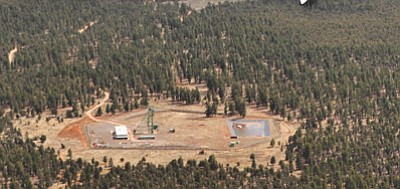Uranium mining to resume at Grand Canyon
U.S. District Judge rules against environmentalist groups and Havasupai Tribe, Canyon Mine to proceed with operations
GRAND CANYON, Ariz. - The U.S. District Court in Phoenix ruled in favor of the U.S. Forest Service allowing the Canyon Mine to proceed with planned operations near the South Rim.
The lawsuit, filed against the Forest Service by environmentalist groups and the Havasupai tribe in 2013, was an attempt to slow down or close operations at the uranium mine, which is located outside the town of Tusayan on the South Rim of the Grand Canyon.
In the ruling on April 7, U.S. District Judge David Campbell granted summary judgment in favor of the Forest Service and ordered the plaintiffs' action terminated.
According to Grand Canyon Trust (GCT), a plaintiff in the case, the lawsuit was filed on the basis of an outdated environmental impact statement (EIS), which was completed in 1986.
The Havasupai Tribe, also a plaintiff in the case, filed the suit claiming the area around the mine as a sacred site.
The court rejected all of the plaintiffs' claims against the Forest Service stating
the Havasupai tribe was properly consulted on matters of sacred areas.
Energy Fuels Resources Inc., one of the largest uranium producers for the United States and operator of Canyon Mine acted as an intervener in the case and said, in a press release, they were pleased by the ruling and plan to proceed in re-opening the mine.
"We are pleased that the federal court rejected the plaintiffs' challenges to the Canyon Mine, which allows us to continue our development of this high-grade deposit," said Stephen P. Antony, president and CEO of Energy Fuels. "The Canyon Mine has been heavily studied, and the technical and geologic characteristics of the project are well-understood. Energy Fuels is absolutely committed to operating the Canyon Mine in a responsible manner, and we are proud to do our part in providing clean energy to the world, as the uranium we produce will reduce air pollution and help address climate change."
The court's decision affirms Energy Fuels' right to continue operations at the mine, but is subject to appeal.
Roger Clark, program director for GCT, said the group plans to study the ruling before deciding whether they will make an appeal in the case.
"We are studying it and feel that he (Judge Campbell) made a narrow ruling," Clark said. "He focused on one specific aspect of the law without really responding to our larger argument. We've made similar arguments before Judge Campbell in the past and got the same results. We do feel that in this particular case we have a good chance in overturning his decision. They're not encumbered unless we are successful in our appeal."
Energy Fuels said they plan to commence operations at the mine within the next several months.
In order to complete the mine, two ventilation shafts and between 1,200 and 1,500 feet of the primary shaft needs to be sunk. The underground development of the mine will also need to be completed.
Prior to closing the mine, temporarily, in 2013, around 275 feet of the mine shaft was sunk.
The Canyon Mine is a "breccia pipe" uranium deposit, which is considered to be one of the highest-grade deposits not only in the U.S. but also around the world, outside of Canada.
According to Energy Fuels and a 2012 Technical Report prepared in accordance with National Instrument 43-101, Canyon Mine deposits have 1.63 million pounds of uranium contained in 83,000 tons of Inferred Mineral Resources.
- Driver identified in fatal accident on Perkinsville Road Sept. 19
- Latest Tik Tok challenges causing problems for Williams Unified School District
- Search at Grand Canyon turns up remains of person missing since 2015
- Plane wreckage and human remains found in Grand Canyon National Park
- Pumpkin Patch Train departs Williams starting Oct. 5
- Update: Man missing in Grand Canyon National Park hike found alive
- Receding water levels at Lake Powell reveal missing car and driver
- Man sentenced for attack on camper at Perkinsville
- Column: Lumber prices expected to stay high through 2022
- Elk rut season in Grand Canyon: What you need to know
SUBMIT FEEDBACK
Click Below to:






